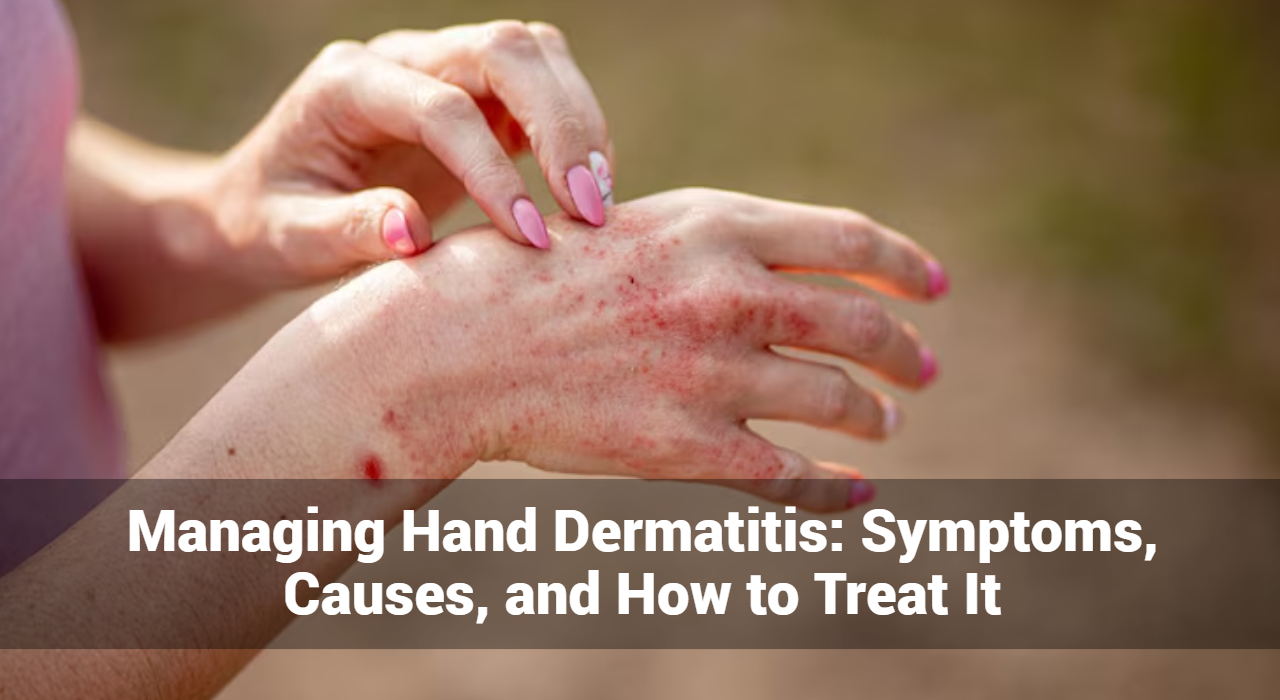Managing Hand Dermatitis: Symptoms, Causes, and How to Treat It

Hand dermatitis, also known as hand eczema, is a common condition that affects many individuals. This inflammatory skin disorder can cause significant discomfort and can interfere with daily activities. Understanding the symptoms, causes, and treatment options for hand dermatitis is crucial for managing this condition effectively.
What Are The Symptoms of Hand Dermatitis?
Hand dermatitis manifests through various symptoms, which can vary in severity. Recognizing these symptoms early can help in managing and treating the condition effectively. Here are the common symptoms of hand dermatitis:
- Redness:
- The skin on the hands appears red and inflamed.
- Redness can vary from mild to intense, depending on the severity of the dermatitis.
- Itching:
- Persistent itching is one of the most common and bothersome symptoms.
- Itching can lead to scratching, which may worsen the condition and cause additional damage to the skin.
- Dryness:
- The skin often becomes extremely dry.
- Dryness can lead to cracks and fissures, which can be painful and increase the risk of infection.
- Blisters:
- Small, fluid-filled blisters may develop on the affected areas.
- These blisters can burst, leaving the skin open and susceptible to secondary infections.
- Swelling:
- Inflammation may cause the hands to swell.
- Swelling can add to the discomfort and make it difficult to use the hands for everyday tasks.
- Scaling and Flaking:
- As the skin heals, it may become scaly and start to flake off.
- This can give the skin a rough, uneven texture.
- Cracking and Fissuring:
- Severe dryness and inflammation can lead to cracks in the skin.
- Fissures can be particularly painful and may bleed, especially in areas subject to movement or pressure.
- Pain and Tenderness:
- The affected areas can be tender to the touch.
- Pain may be constant or occur only when the skin is stretched or touched.
- Thickening of the Skin:
- Chronic dermatitis can cause the skin to thicken, a condition known as lichenification.
- This thickened skin can be tough and leathery.
- Burning Sensation:
- Some individuals may experience a burning sensation in the affected areas.
- This can add to the overall discomfort and make it challenging to perform daily activities.
Track and Manage your Eczema treatment using a comprehensive Eczema App
Download Eczemaless now
What Causes of Hand Dermatitis?
Hand dermatitis can be triggered by various factors, which are generally categorized into two main types: irritant contact dermatitis and allergic contact dermatitis.
Irritant Contact Dermatitis
This type of dermatitis occurs when the skin comes into contact with irritants. Common irritants include:
- Chemicals: Frequent exposure to cleaning agents, detergents, and solvents can damage the skin barrier.
- Water: Prolonged exposure to water, especially hard water, can strip the skin of its natural oils.
- Friction: Repeated rubbing or friction can cause irritation, leading to dermatitis.
- Temperature Extremes: Very hot or cold conditions can aggravate the skin.
Allergic contact dermatitis is an immune reaction to specific allergens. Common allergens include:
- Nickel: Found in jewelry, zippers, and other metal objects.
- Latex: Common in gloves and some medical equipment.
- Fragrances and Preservatives: Present in personal care products like lotions, soaps, and shampoos.
- Plants: Certain plants, such as poison ivy, can cause allergic reactions.
Diagnosis of Hand Dermatitis
Diagnosing hand dermatitis typically involves:
- Physical Examination: A dermatologist will examine the affected skin and take a detailed medical history.
- Patch Testing: This test identifies specific allergens that may be causing the dermatitis.
- Skin Biopsy: In rare cases, a small sample of skin may be taken to rule out other conditions.
Treatment Options for Hand Dermatitis
Effective management of hand dermatitis involves a combination of treatments and lifestyle adjustments.
Topical Treatments
- Moisturizers: Regular use of emollients can help restore the skin barrier and prevent dryness.
- Corticosteroids: Topical steroids reduce inflammation and itching. They should be used under medical supervision.
- Calcineurin Inhibitors: Non-steroidal medications that help reduce inflammation.
- Barrier Creams: These protect the skin from irritants and allergens.
Oral Medications
- Antihistamines: These can help reduce itching and improve sleep.
- Systemic Corticosteroids: For severe cases, oral steroids may be prescribed for a short period.
- Immunosuppressants: Medications like cyclosporine may be used in chronic cases.
Phototherapy
- UV Light Therapy: Controlled exposure to ultraviolet light can reduce inflammation and improve symptoms.
GET IN CONTROL OF YOUR ECZEMA
Use our AI tool to check the severity of Eczema and keep track of your Eczema progress.
Home Remedies and Lifestyle Changes for Hand Dermatitis
Hand dermatitis, or hand eczema, can often be managed effectively with simple home remedies and lifestyle adjustments. These methods can help reduce symptoms and prevent flare-ups. Here are some recommended home remedies and lifestyle changes for managing hand dermatitis:
- Moisturize Regularly:
- Use emollients: Apply moisturizing creams or ointments multiple times a day, especially after washing hands or when the skin feels dry. Look for products that are fragrance-free and hypoallergenic to minimize irritation.
- Gentle Cleansing:
- Use mild soaps: Choose gentle, fragrance-free soaps and hand washes that are formulated for sensitive skin.
- Avoid hot water: Wash hands with lukewarm water, as hot water can strip the skin of its natural oils and worsen dryness.
- Protective Measures:
- Wear gloves: Protect your hands from irritants and allergens by wearing gloves when performing tasks that involve exposure to chemicals, water, or other potential triggers.
- Cotton liners: Wear cotton gloves underneath protective gloves to absorb sweat and prevent irritation.
- Avoid Triggering Substances:
- Identify triggers: Keep a diary to track activities and exposures that seem to exacerbate your symptoms. Common triggers include certain soaps, detergents, solvents, and metals like nickel.
- Avoid known allergens: If you have identified specific allergens through patch testing, take steps to minimize exposure to these substances.
- Oatmeal Baths:
- Soothe irritated skin: Add colloidal oatmeal to lukewarm bathwater and soak your hands for 10-15 minutes. Oatmeal has anti-inflammatory properties that can help relieve itching and reduce redness.
- Aloe Vera Gel:
- Natural soothing agent: Apply pure aloe vera gel to the affected areas to soothe inflammation and promote healing. Aloe vera has moisturizing and anti-inflammatory properties.
- Avoid Scratching:
- Trim nails: Keep your nails short to minimize damage from scratching. Consider wearing cotton gloves at night to prevent scratching during sleep.
- Humidify the Air:
- Use a humidifier: In dry environments, a humidifier can help maintain moisture levels in the air, which can prevent excessive drying of the skin.
- Stress Management:
- Reduce stress: Stress can exacerbate inflammatory skin conditions like dermatitis. Practice stress-relieving techniques such as yoga, meditation, or deep breathing exercises.
- Dietary Considerations:
- Omega-3 fatty acids: Incorporate foods rich in omega-3 fatty acids, such as salmon, flaxseeds, and walnuts, which have anti-inflammatory properties that may benefit skin health.
- Hydration: Drink plenty of water throughout the day to keep your skin hydrated from the inside out.
When to Seek Medical Advice
While home remedies can be effective for mild cases of hand dermatitis, it’s important to consult a dermatologist if:
- Your symptoms are severe or persistent despite home treatment.
- You develop signs of infection, such as increased redness, swelling, warmth, or pus.
- Your daily activities are significantly impacted by hand dermatitis.
A dermatologist can provide a proper diagnosis, recommend appropriate treatments, and help you manage chronic or severe cases of hand dermatitis effectively.
Prevention of Hand Dermatitis
Preventing hand dermatitis involves proactive measures to protect the skin:
- Skin Protection: Wear gloves when exposed to potential irritants or allergens.
- Regular Moisturizing: Apply moisturizers frequently, especially after washing hands.
- Gentle Cleansing: Use mild soaps and avoid hot water.
- Avoidance: Stay away from known triggers and allergens.
- Education: Learn about common irritants and allergens to better manage exposure.
Conclusion
Hand dermatitis can be a challenging condition, but with proper management and treatment, symptoms can be controlled effectively. Understanding the causes, recognizing the symptoms, and implementing the right treatment strategies are key to managing hand dermatitis and maintaining healthy skin.
Track and Manage your Eczema treatment using a comprehensive Eczema App
Download Eczemaless now



